

I haven't sent an engine oil sample to the lab for a few years. I didn't think there was much value in it anymore for me after establishing a trend in my engine. All the oils were satisfactory and performed well within acceptable limits. This lab analysis was to determine if there was any measurable effect on the engine by changing the air filter. Could I measure a difference in airborne dirt passed by the air filter and into the engine oil and would this effect any of the wear metals? Oil used for this 5000 km stint was Penrite HPR10, a 10W-50 oil. This is the "recommended" oil for the 1JZGTE and 1UZ-FE. I got it because it's cheap, easily available, correct weight and will easily survive 5000km in my engine.
Toyota 1UZ-FE V8 engine oil analysis |
||||||||||
DATE SAMPLED |
12-Jul-01 |
15-Feb-02 |
5-Mar-02 |
5-Apr-02 |
2-Jul-02 |
20-Sep-02 |
9-Nov-02 |
25-Jan-03 |
4-Apr-03 |
1-Nov-04 |
MACHINE (km) |
76,000 |
81,000 |
86,000 |
90,100 |
95,930 |
100,032 |
105,000 |
111,080 |
114,250 |
146000 |
OIL (km) |
Japan |
5,000 |
4,500 |
4,500 |
5,830 |
4,070 |
5,000 |
6,000 |
3,170 |
5000 |
OIL MAKE (Km) |
? |
Penrite HPR 15 |
Shell Helix Plus |
Havoline Energy |
Castrol Magnatec |
Mobil 1 |
Mobil 1 |
ULX-110 |
ULX-110 |
Penrite HPR 10 |
Oil type |
? |
Semi Synthetic |
Semi Synthetic |
Semi Synthetic |
Semi Synthetic |
Full Syn |
Full Syn |
Mineral |
Mineral |
Semi Synthetic |
OIL GRADE |
? |
15W-60 |
15W50 |
5W30 |
10W30 |
5W50 |
5W50 |
10W30 |
20W30 |
10W-50 |
OIL ADDED (litres) |
? |
0 |
0 |
0 |
0 |
0 |
0 |
0.6 |
0.5 |
0 |
FILTER |
? |
Ryco |
Ryco |
Ryco |
Toyota |
FSA |
FSA |
Ryco |
Ryco |
Ryco |
Wear Metals (ppm) |
||||||||||
Iron (Fe) |
4 |
9 |
6 |
9 |
14 |
13 |
10 |
13 |
10 |
4 |
Aluminium (AI) |
2 |
2 |
2 |
<1 |
6 |
5 |
6 |
18 |
21 |
<1 |
Copper (Cu) |
2 |
3 |
1 |
1 |
2 |
1 |
1 |
1 |
1 |
<1 |
Chromium (Cr) |
<1 |
<1 |
<1 |
<1 |
1 |
1 |
1 |
<1 |
<1 |
<1 |
Lead (Pb) |
1 |
8 |
4 |
5 |
6 |
7 |
10 |
11 |
<1 |
2 |
Tin (Sn) |
1 |
<1 |
<1 |
<1 |
1 |
1 |
1 |
<1 |
<1 |
<1 |
Other Metals/Additives (ppm) |
||||||||||
Molybdenum (Mo) |
287 |
28 |
25 |
760 |
94 |
164 |
153 |
826 |
970 |
4 |
Zinc (Zn) |
1140 |
922 |
960 |
1044 |
960 |
1223 |
1335 |
1051 |
1040 |
989 |
Phosphorus (P) |
967 |
798 |
813 |
896 |
835 |
1053 |
1135 |
1660 |
907 |
|
Potassium (K) |
1 |
8 |
19 |
5 |
3 |
2 |
1 |
1 |
1 |
<1 |
Magnesium (Mg) |
450 |
80 |
42 |
21 |
283 |
553 |
583 |
19 |
218 |
|
Calcium (Ca) |
2137 |
2770 |
2876 |
2032 |
1953 |
2360 |
2883 |
2412 |
2471 |
2135 |
Manganese (Mn) |
<1 |
1 |
4 |
124 |
9 |
n/a |
n/a |
|||
Contaminants (ppm) |
||||||||||
Water (°.6 by FTIR) |
<0.1 |
<0.1 |
<0.1 |
<0.1 |
<0.1 |
<0.1 |
<0.1 |
<0.1 |
<0.1 |
|
Silicon (Si) |
11 |
12 |
9 |
7 |
13 |
13 |
11 |
15 |
15 |
3 |
Boron (B) |
85 |
5 |
17 |
5 |
69 |
134 |
137 |
5 |
241 |
12 |
Sodium (Na) |
4 |
6 |
5 |
7 |
49 |
4 |
<1 |
15 |
5 |
<1 |
Physical Tests |
||||||||||
Viscosity (cSt,40°C) |
111 |
139 |
121 |
62 |
104 |
103 |
100 |
84.6 |
119 |
|
Viscosity (cSt,100°C) |
13 |
17.8 |
||||||||
Glycol Index |
0.1 |
0.5 |
0.4 |
<0.1 |
0.1 |
<0.1 |
<0.1 |
<0.1 |
<1 |
|
PQ Index |
41 |
39 |
32 |
34 |
49 |
77 |
47 |
13 |
18 |
13 |
Nitration Index |
10.9 |
10.4 |
10 |
10.9 |
11.4 |
12.4 |
11.7 |
11 |
10 |
5 |
Petrol (°.6 by Distillation) |
1.5 |
2 |
1.5 |
1 |
1.5 |
2 |
1.5 |
3 |
1.2 |
|
Si:Al ratio |
5.5 |
6 |
4.5 |
7 |
2.17 |
2.6 |
1.83 |
0.83 |
0.71 | >3 |
| Engine problems predicted with oil analysis. | |||
| Indicator | Acceptable Levels | Engine Problem | What to Check |
| Silicon (Si) and Aluminum (Al) |
10 to 30 ppm | Dirt ingestion | Air intake system, oil filter plugging, oil filler cap and breather, valve covers, oil supply |
| Iron (Fe) | 100 to 200 ppm | Wear of cylinder liner, valve and gear train, oil pump, rust in system | Excessive oil consumption, abnormal engine noise,performance problems, oil pressure, abnormal operating temperatures, stuck/broken piston rings |
| Chromium (CR) | 10 to 30 ppm | Piston ring wear | Excessive oil blow-by and oil consumption, oil degradation |
| Copper (CU) | 10 to 50 ppm | Bearings and bushings wear, oil cooler passivating,radiator corrosion | Coolant in engine oil, abnormal noise when operating at near stall speed |
| Lead (Pb)* | 40 to 100 ppm | Bearing corrosion | Extended oil change intervals |
| Copper (CU) and Lead (Pb)* |
10 to 50 ppm | Bearing lining wear | Oil pressure, abnormal engine noise, dirt being ingested in air intake, fuel dilution, extended oil drain intervals |
| Aluminum (Al) | 10 to 30 ppm | Piston and piston thrust bearing wear | Blow-by gases, oil consumption, power loss, abnormal engine noise |
| Silver and Tin |
2 to 5 ppm 10 to 30 ppm |
Wear of bearings | Excessive oil consumption, abnormal engine noise, loss in oil pressure |
| Viscosity Change | Lack of lubrication | Fuel dilution, blow-by gases, oil oxidation, carburetor choke, ignition timing, injectors, injector pump, oil pressure | |
| Water/Anti-freeze | Coolant leak or condensation | Coolant supply, gasket sealed, hose connection, oil filler cap and breather | |
So checking the Silicon values as an indicator of air intake leaks:
![]()
The silicon levels in the oil are satisfactory. So no warning bells about the TRD air filter here. There are several web pages regarding the filtering efficiency of various filters. For example http://www.bobistheoilguy.com/airfilter/airtest3.htm . I didn't do this sort of test. I wanted to measure the effect on the engine directly from different filters by engine oil analysis.
Checking the wear metals next:
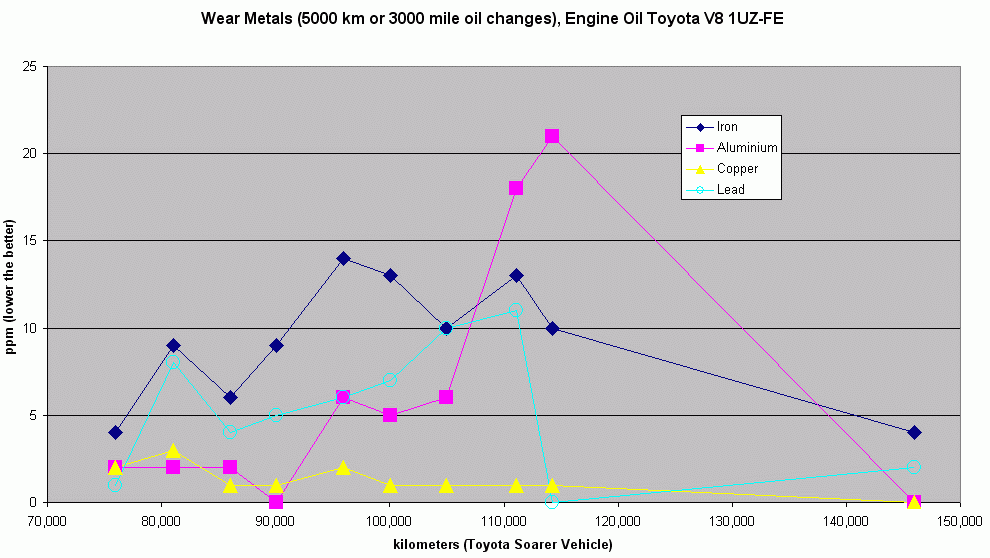
The wear metals are also still satisfactory. The TRD air filter is satisfactory for my engine. I wouldn't mind doing another test to see if these low values continue. This does not mean that the TRD filter has out performed the other filters. The differing values also reflect the chemistry of the different brands of oil and their own approach. Because the brand of oil has been changed as well as the filter it is not possible to compare one air filter to another
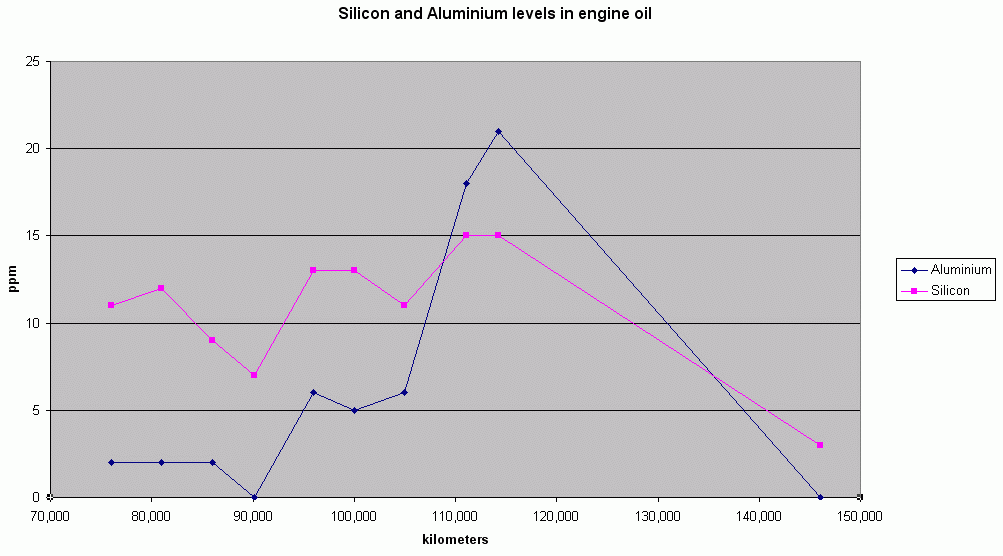
Silicon/aluminum ratio in dirt varies by location -
The primary constituents of dirt are minerals containing silicon and aluminum. The ratio of these two elements varies widely from place to place. Clay soils contain nearly as much aluminum as silicon. This is one reason why local interpretation of results is important. Silica and alumina are typically present in dirt and dust in the approximate ratio 3.4:1, with silica being the major component and alumina the minor component. Spectrometric analysis of oil samples that contain high levels of dirt and dust typically reflect this ratio of silica to alumina in the ppm of silicon and aluminum measured. It would appear that there is a relationship between silicon and aluminium in my engine oil. Silicon goes up, aluminium goes up, silicon goes down, aluminium goes down. This sort of relationship indicates dirt ingress. The odd ones out are the two ULX-110 engine oil samples. These are the only two samples where the aluminium is higher than the silicon. ULX-110 add silicon and aluminium to new oil as part of an additive package and so do not reflect extra dirt ingress or wear metals compared to the other samples. Long term trends are more important than absolute limits.Solid particles are one of the most destructive contaminants. Dust and dirt getting into the reservoirs from the environment and poor lubrication practices are the most common source of surface damage and wear. Maintaining lubricants free of dirt is a smart proactive action that can significantly increase the life of your machinery.
Consider this: silicon (Si) is an indicator of dirt in our lubricants. The earth's outer layer, is 4 to 60 kilometers thick. The crust, as this layer is known, is rich in oxygen and silica with lesser amounts of aluminum, iron, calcium, potassium, sodium and magnesium.
Average composition of the earth's crust:
SiO2 - 58.09%
AlO3 - 15.35%
FeO3 - 7.29%
Ca - 3.6%
Na - 2.97%
K - 2.57%
Mg - 2.11%
This indicates that the predominant elements are silicon (Si) and aluminum (Al). Keep in mind, however, that not all the places in the world will have the same metals in the same proportion. (source http://www.lube-tips.com )
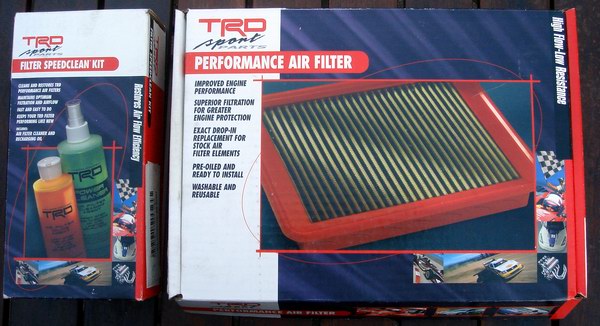
Part number looks to be 17801 - JA810 (Japanese ?) or 17801-002 for V6 Tacoma/4 runner - I'm not positive about that number.
In Australia check with James Sloane (ring toll free on 1800 111 388 or NSW on 02 8831 8831) Castle Hill Toyota Parts in NSW for your special price. He can post one out to you no problems.
We have done some testing on different types of panel filters in the Toyota Soarer here. So for me I'll be leaving my TRD filter in full-time. I'm just extra careful not to damage it while cleaning by squirting it with the hose or blowing it with compressed air when cleaning. Nice and gentle does it.
Got a warning from the Castrol Oil Analysis lab with my 2nd ULX-110 sample - "small amount of contaminants indicated" - this may well indicate the chemistry of the ULX-110 as they add silicon and aluminium to their new oil. All results were acceptable for the 2nd ULX-110 sample. Even more moly in this sample and the boron is through the roof. Same ULX oil - just the thicker 20W this time - previously it was the 10W oil - I have never heard of so much molybdenum in an oil sample before. After switching back to the Toyota filter I see if I can get a oiled cotton or foam filter to try - see if it affects the contaminants.
Use full syn for the TT, a quality 10w approx for the V8, change oil and filter every 5000km or 3000 miles
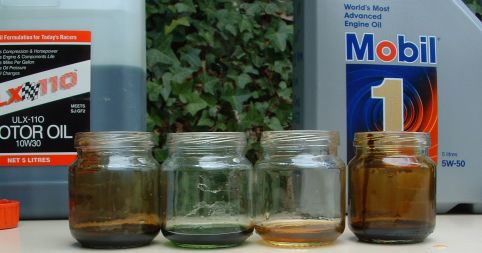
Left to right in the little jars: Old ULX, new ULX, new Mobil 1, old Mobil 1. Different colours when new, same icky brown/black after 5000 odd kms.
Had a big jump in aluminium with the ULX-110 (it's an additive). Still acceptable. The viscosity of ULX - it is thinner than Mobil 1, thicker than Havoline. Energy. ULX has the highest molybdenum content I have ever seen in an oil - higher than Havoline. Energy. Results in table below. Second lot of ULX has been drained and is off to the lab. Shell Helix Ultra 5W-50 is now in the car, I mean if it's good enough for a Ferrari then it should be ok for my beloved Soarer! I wanted a thinner oil full syn oil that would easily cope with 60 laps of Phillip Island with the foot mashed to the floor and the 10 hour drive home.
AND you can't get oils that don't mix any more. So you can go from mineral to full syn and back - the oil won't curdle or thicken. Old engines may use and leak more oil of a lower viscosity compared to a thicker oil.
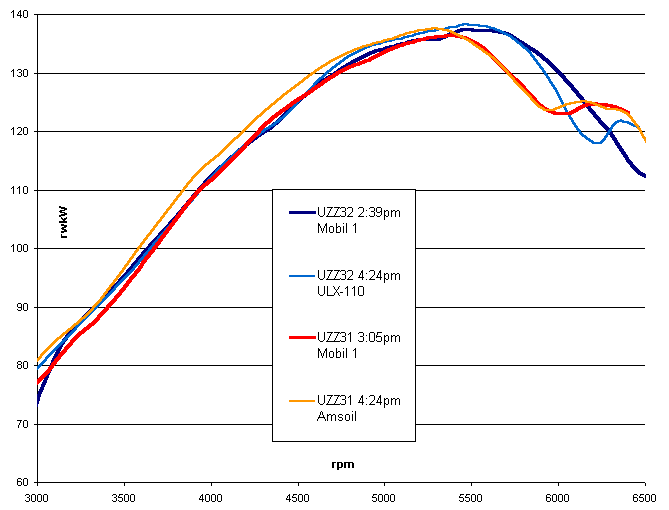
Check the above graph. Aaron and I did a dyno before and after the oil change. This isn't any big budget affair - I changed the oil in the carpark while Aaron warmed up the cars and circulated the new oil before a dyno. It was old (5000-6000km) Mobil 1 versus new oil - not new versus new. Lot's of things weren't very scientific about the test we know. Anyway Aaron's graphs are the red and orange. I have picked out two dyno graphs that give the impression that Amsoil makes more power than Mobil 1. I have also changed the power scale so it doesn't start at zero - it starts at 60 - this makes changes appear bigger.
The light blue and dark blue lines are my car. I have modified exhaust cams - that may explain why my car appears to keep making power longer than Aaron's - our rear tyres are similar in diameter. Looking at the graphs it would also appear that I get more power from the the new ULX than the Mobil. Perhaps- but when you look at all the graphs below there isn't much in it. In fact when Aaron and I were watching the graphs on the screen live being overlayed - we reckoned there wasn't anything in it at all. Aaron had bigger variations the first time around. He was mucking around with a Apexi SAFC - got the fuel mixtures right - didn't affect power that much on the V8 - he has sold the SAFC now.
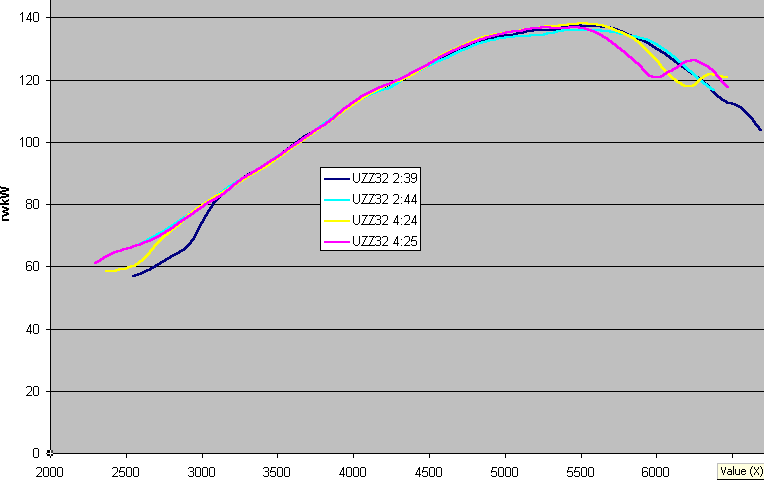
Here are all the graphs on my car with the full scale. Two runs before and two runs after the ULX oil change. Not much in it is there? Depends on which graphs you take as to which story you want to push. If you look at the times of the dyno you can see how long it took Aaron and I to do it. ULX said to me to flush oil with Mineral first since I have full syn Mobil 1. So I had to do two changes before the next dyno lying on my back on hot asphalt carpark.
So all up ULX did not make more power in my V8, it did not protect my V8 any better or worse.
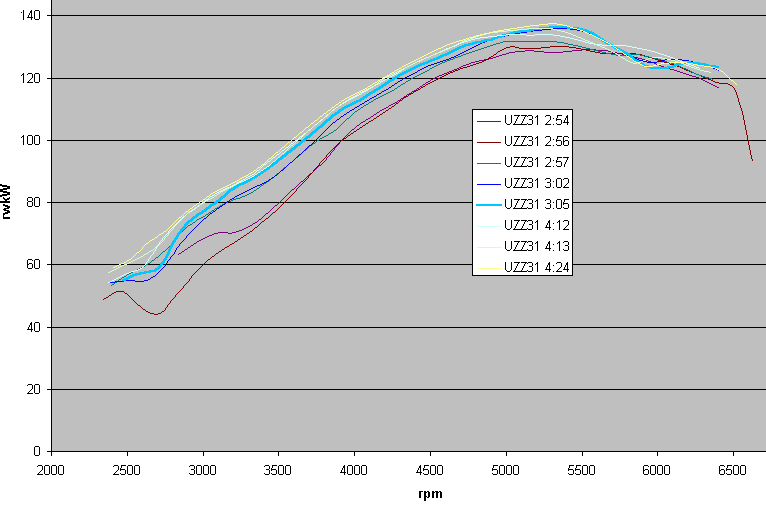
Here are all of Aaron's graphs. He changed from Mobil 1 to Amsoil. The car was all over the place and got better with every run. I couldn't really say that new Amsoil is better than old Mobil 1 in Aaron's car either - the data is too sketchy. It does look better in places but we didn't get a consistent baseline - the car kept improving - it might have been the same without the oil change. We haven't analysed the oil in Aaron's engine. Since Amsoil is hard to get and dearer than Mobil 1 he won't be using it again.
So here ends our foray into the boutique oils - I'm going back to the Majors - I reckon after the Ultra it's time to revisit Shell Helix Plus.
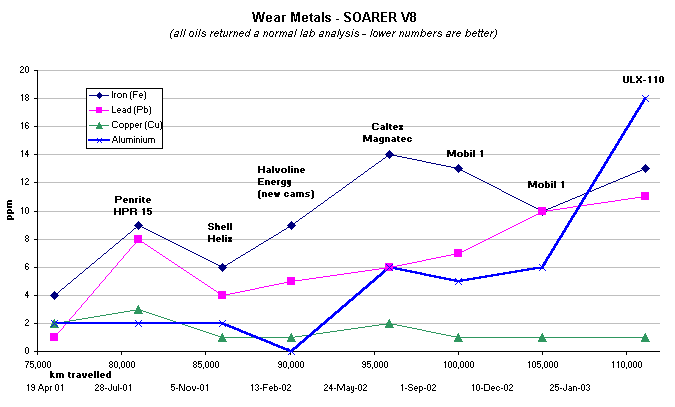
SAMPLE STATUS |
Normal |
Normal |
Normal |
Normal |
Normal |
Normal |
Normal |
|||||
LAB CHECK NO. |
5073910 |
5210092 |
5210345 |
5210098 |
5226943 |
1341609 |
1341610 |
20030331-0301 |
20030428-0201 | In the car now | ||
ANALYSIS NO. |
3026395 |
3048427 |
3058671 |
3058672 |
3069363 |
1560356 |
156115 |
|||||
DATE SAMPLED |
12-Jul-01 |
15-Feb-02 |
5-Mar-02 |
5-Apr-02 |
2-Jul-02 |
20-Sep-02 |
9-Nov-02 |
25-Jan-03 |
4-Apr-03 |
|||
DATE RECEIVED |
16-Jul-01 |
18-Feb-02 |
21-May-02 |
21-May-02 |
15-Jul-02 |
15-Dec-02 |
2-Dec-02 |
31-Mar-03 |
28-Apr-03 | |||
DATE REPORTED |
16-Jul-01 |
19-Feb-02 |
22-May-02 |
22-Feb-02 |
15-Jul-02 |
10/12/02 |
4/12/02 |
31-Mar-03 |
28-Apr-03 | |||
MACHINE (Kms) |
76,000 |
81,000 |
86,000 |
90,100 |
95,930 |
100,032 |
105,000 |
111,080 |
114,250 |
|||
OIL (Kms) |
Japan |
5,000 |
4,500 |
4,500 |
5,830 |
4,070 |
5,000 |
6,000 |
3,170 |
|||
OIL MAKE (Kms) |
Japan |
Penrite HPR 15 |
Helix Plus |
Havoline Energy |
Castrol Magnatec |
Mobil 1 |
Mobil 1 |
ULX-110 |
ULX-110 |
Shell Ultra |
||
Oil type |
Semi Synthetic |
Semi Synthetic |
Semi Synthetic |
Semi Syn |
Full Syn |
Full Syn |
Mineral |
Mineral |
Full Syn |
|||
OIL GRADE (Ltrs) |
Japan |
15W-60 |
15W50 |
5W30 |
10W30 |
5W50 |
5W50 |
10W30 |
20W30 |
5W-50 |
||
OIL ADDED (Kms) |
Japan |
0 |
0 |
0 |
0 |
0 |
0 |
0.6 |
0.5 |
|||
FILTER (Kms) |
Japan |
Ryco |
Ryco |
Ryco |
Toyota |
FSA |
FSA |
Ryco |
Ryco |
Ryco |
||
Wear Metals (ppm) |
Iron (Fe) |
4 |
9 |
6 |
9 |
Iron (Fe) |
14 |
13 |
10 |
13 |
10 | |
Aluminium (AI) |
2 |
2 |
2 |
<1 |
Aluminium (AI) |
6 |
5 |
6 |
18 | 21 | ||
Copper (Cu) |
2 |
3 |
1 |
1 |
Copper (Cu) |
2 |
1 |
1 |
1 |
1 | ||
Chromium (Cr) |
<1 |
<1 |
<1 |
<1 |
Chromium (Cr) |
1 |
1 |
1 |
<1 |
<1 | ||
Lead (Pb) |
1 |
8 |
4 |
5 |
Lead (Pb) |
6 |
7 |
10 |
11 |
<1 | ||
Tin (Sn) |
1 |
<1 |
<1 |
<1 |
Tin (Sn) |
1 |
1 |
1 |
<1 |
<1 | ||
Other Metals (ppm) |
Molybdenum (Mo) |
287 |
28 |
25 |
760 |
Molybdenum (Mo) |
94 |
164 |
153 |
826 | 970 | |
Zinc (Zn) |
1140 |
922 |
960 |
1044 |
Zinc (Zn) |
960 |
1223 |
1335 |
1051 |
1040 | ||
Phosphorus (P) |
967 |
798 |
813 |
896 |
Phosphorus (P) |
835 |
1053 |
1135 |
1660 | |||
Potassium (K) |
1 |
8 |
19 |
5 |
Potassium (K) |
3 |
2 |
1 |
1 |
1 | ||
Magnesium (Mg) |
450 |
80 |
42 |
21 |
Magnesium (Mg) |
283 |
553 |
583 |
19 | |||
Calcium (Ca) |
2137 |
2770 |
2876 |
2032 |
Calcium (Ca) |
1953 |
2360 |
2883 |
2412 |
2471 | ||
Manganese (Mn) |
<1 |
1 |
4 |
124 |
Manganese (Mn) |
9 |
n/a |
n/a |
||||
Contaminants (ppm) |
Water (°.6 by FTIR) |
<0.1 |
<0.1 |
<0.1 |
<0.1 |
Water (°.6 by FTIR) |
<0.1 |
<0.1 |
<0.1 |
<0.1 | ||
Silicon (Si) |
11 |
12 |
9 |
7 |
Silicon (Si) |
13 |
13 |
11 |
15 |
15 | ||
Boron (B) |
85 |
5 |
17 |
5 |
Boron (B) |
69 |
134 |
137 |
5 |
241 | ||
Sodium (Na) |
4 |
6 |
5 |
7 |
Sodium (Na) |
49 |
4 |
<1 |
15 |
5 | ||
Physical tests |
Viscosity (cSt,40°C) |
111 |
139 |
121 |
62 |
Viscosity (cSt,40°C) |
104 |
103 |
100 |
84.6 |
||
| Viscosity (cSt,100°C) | Viscosity (cSt,100°C) | 13 | ||||||||||
Glycol Index |
0.1 |
0.5 |
0.4 |
<0.1 |
Glycol Index |
0.1 |
<0.1 |
<0.1 |
<0.1 |
|||
PQ Index |
41 |
39 |
32 |
34 |
PQ Index |
49 |
77 |
47 |
13 |
18 | ||
Nitration Index |
10.9 |
10.4 |
10 |
10.9 |
Nitration Index |
11.4 |
12.4 |
11.7 |
11 |
10 | ||
Petrol (°.6 by Distillation) |
1.5 |
2 |
1.5 |
1 |
Petrol (°.6 by Distillation) |
1.5 |
2 |
1.5 |
3 |
|||
Si:Al ratio |
5.5 |
6 |
4.5 |
7 |
Si:Al ratio |
2.17 |
2.60 |
1.83 |
0.83 |
0.83 |
Two Mobil 1 oil analyses are back. The Mobil 1 did not protect the engine any better than any other oil over 5000 km. I don't care that the oil may have lasted longer - the crud still builds up and the filter still gets blocked - so 5000 km it will always be for me. The Mobil has been swapped for ULX-110 - a mineral oil. Haven't been able to measure a difference due to different oil filters. The Mobil 1 tested viscosity appears to be thicker than the specs - this is odd.
Castrol Magnatec analysis is back. All the oils tested so far have a normal wear profile - so all are ok for the V8. Favourite oil so far would be the Havoline Energy.
Summary:
I use good quality Semi Synthetic oil for my V8 Soarer changed every 5000km (approx 3000
miles) with genuine Toyota oil filter changed at same time.
For the Twin Turbo go for full synthetic oil, still change every 5000 km with new genuine
Toyota Filter.
I love anecdotal evidence such as "I only use Brand X air filters and when I tore down the motor there was no abnormal wear - it is a great filter." and " I have used Brand Y oil and have had no problems".
Getting an oil analysis will tell you how well your oil is protecting your engine and how much dirt is getting in (through the air filter for example) - nothing else will. So if you are presented with information about how well a filter filters or how good an oil is for your engine, don't decide straight away if the information is wrong or right, just file it away in the evidence section of your brain. An oil analysis done in your sort of car with your sort of driving in your sort of local climate conditions will be one of the strongest pieces of evidence you can get. Stronger again if done over a period of time with several changes of oil - the trends can be more important than the actual values.
I couldn't get one person to recommend synthetic oil for my V8. Not the Lexus service
mechanic, not the Toyota guy, not the Dyno tune race guy. They all said the same thing -
semi synthetic. 10 000 km intervals from Lexus/Toyota (Castrol TXT softec) and 5000km if
your fussy from the race guy (Penrite HPR Pedigree Synthetic Fortified 15W/60).
Synthetic oil was recommended for the twin turbo engines.
How would I know if the oil was doing the job? There is only one way - getting the old oil
analysed. I put some in a fruit juice bottle and gave it to my brother Andrew at
MotorMate. He gave it to the Castrol rep who held it up to the light, smelt it, tagged it
and took it away.
They now have me on file, each oil analysis is compared to the previous one and trends are
plotted. They let me know how things are going.
I won't let them know what type of oil it is (well I do after the first couple of tests -
I'm getting it for free still so the least I can do give them the brand of oil - I
shouldn't really should I? - it is a Castrol Lab and strictly speaking to be impartial
they shouldn't know the brand of oil until afterwards. They always ask. hmmmm) I want it
to be a blind test. I change the oil every 5000 km.
I drained the hot oil over night with the car jacked up slightly higher on the battery
side - this allowed the oil to drain completely to the sump plug on the throttle side
(RHS) (V8). The oil filter was removed too.
I then fitted a new oil filter, refilled the oil, added the oil engine clean additive, ran
for 30 mins and drained overnight again.
Then I refilled and replaced the oil filter again. 2 oil changes and 2 filters in 2 days
was done only because I didn't know the oil history of the engine.
Now I just jack it up and let it drain for an hour.
The oil analysis is supposed to be real cheap - I don't know how cheap because my brother
owns the autoparts store so they did it for him for free.
So if you are curious ask them - they might do the first one for free.
Semi Synthetic (15W-60) oil survived 5000 km in my car, some long trips interstate, lots of full throttle driving, sealed roads, warm summer, low humidity, 300m above sea level, genuine Toyota air filter. The oil that came with the car from Japan was ok too. Both samples got a "Normal" rating. There are no "Sweeet" or "Cool" ratings!
There are four ratings for the oil analysis, Normal, Caution, Abnormal and Severe. They've all been Normal so far.
Wear Metals (ppm) |
|
Iron (Fe) |
Gears, roller bearings, cylinder/liners, shafts |
Aluminium (AI) |
Pistons, journal bearings, dirt |
Copper (Cu) |
Brass/bronze bushes, gears, thrust washers, oil cooler cores, internal coolant leaks |
Chromium (Cr) |
Roller bearings, piston rings |
Lead (Pb) |
Journal bearings, grease, petrol contamination |
Tin (Sn) |
Bronze bushes, washers and gears |
Other Metals (ppm) |
|
Molybdenum (Mo) |
oil additive, rings (Molybdenum DiThioCarbamate as a friction modifier) |
Zinc (Zn) |
Additive (antiwear) |
Phosphorus (P) |
Additive (antiwear, extreme pressure) |
Potassium (K) |
|
Magnesium (Mg) |
Additive, sea water contamination |
Calcium (Ca) |
detergent additive |
Manganese (Mn) |
|
Contaminants (ppm) |
|
Water (°.6 by FTIR) |
|
Silicon (Si) |
Airborne dirt, sealers, gaskets, antifreeze inhibitors |
Boron (B) |
Additive, internal coolant leak, brake fluid contamination |
Sodium (Na) |
Internal coolant leaks, additive, sea water contamination |
Viscosity (cSt,40°C) |
15W oils have higher viscosity than the 5W oils Viscosity of Castrol Oils: GTX3 104, TXT softec 70, GTX Magnatec 105 |
Glycol Index |
|
PQ Index |
Particle Quantification Index - measure of the bulk magnetic content of oil (iron). I have low PQ and low Iron (ppm) - normal wear profile. |
Nitration Index |
|
Petrol (°.6 by Distillation) |
|
Si:Al ratio |
Ratio between 2 and 10 - ok |
IF YOU HAVE ANY INQUIRIES, contact the Labcheck Laboratory on: BRISBANE: Tel (07) 3243 7200 Fax (07) 4234 7221 PERTH: Tel (08) 9249 2636 Fax (08) 9249 2942 SYDNEY: Tel (02) 8784 8666 Fax (02) 8784 8600 SINGAPORE: Tel (65) 743 4311 Fax (65) 283 9689
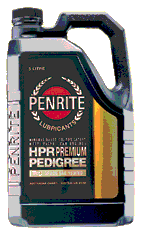 cost : $26 - just gone up since cost : $26 - just gone up since |
The oil that came in car from Japan (unknown) was tested and came up ok. Then I
went for Penrite HPR Premium for $26. Recommended to me Keen Dyno - he reckons this oil is
the go for for non-turbo cars. Oil analysis for this is above. Did 5000km on this oil.
5000 km is recommended no matter what, the engine may be dirty from unknown history, gets
contaminated by fuel, water and dirt, and the additives get used up no matter how long the
oil lasts, and the oil filter can get blocked and go to bypass mode. Doesn't matter how
good the oil is or how long the oil lasts, change filter (at least) and oil every 5000 km
- so full syn or not 5000 km is enough for me. Penrite recommend HPR 10 for the 1UZ-FE V8
An SAE 15W-60 semi-synthetic engine oil formulated for use in latest technology multivalve- multicam computer managed or conventional engines. Exceeds API SL/CF performance levels and those of ACEA A3/B3. Non friction modified. Primarily intended for: · Petrol fuelled cars (including turbocharged); · LPG fuelled cars. Can also be used in petrol and LPG fuelled four wheel drive recreational and light commercial vehicles (up to 3.5 t GVM) and diesel fuelled cars (including turbocharged). Meets the lubrication requirements of Porsche. For diesel fuelled four wheel drive recreational and light commercial vehicles, our primary recommendation is HPR Diesel 20W-60 or for new vehicles subjected to light work or for use in extreme cold, HPR Diesel Light 15W-40. |
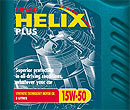 Cost: $28 roughly |
After the Penrite in went some Shell Helix Plus - only in for about 4500 km before the ALSC dyno day where it was changed for the Havoline. Shell recommend Shell Helix Ultra 15W-50 or Shell Helix Plus. About $28 Shell Helix Plus takes the worry out of choosing the right oil. Whatever your vehicle and however hard it is driven, Shell Helix Plus provides better protection than most conventional oils. That's why it meets nearly all handbook recommendations demanded by your vehicle manufacturer*. Shell Helix Plus is synthetic technology motor oil, which enables it to provide the highest levels of protection and performance. Available in 500ml, 1 litre and 5 litre |
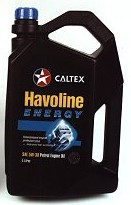 Cost:
mid $40 Cost:
mid $40
|
At the ALSC dyno day I replaced the Shell Helix oil with HAVOLINE Energy and a new filter. I had read reports of a 6% fuel saving in independent magazine tests - on the dyno we got a 3 kW increase across the range - hardly a scientific test as the Shell Oil was already 4500 km old. This oil has done about 4500 km too before the oil change for the new camshafts. Cost about $40 only from Caltex service stations. Caltex recommend HAVOLINE FORMULA 3 20W-50 or HAVOLINE FULLY SYNTHETIC http://www.caltex.com.au/products_oil_detail.asp?id=99
|
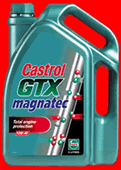 Cost: hmmm, forget - mid $30's?
|
Castrol GTX Magnatec 10w40. I got it specifically because of the advertising about clinging to metal parts (ie new camshafts) - a big carrot for a donkey like me who wants his new camshafts to last and last! This is the oil recommended by Castrol for the 1UZ-FE V8 ($28). For the TT only full syn will do to cope with the turbo heat. CASTROL GTX MAGNATEC |
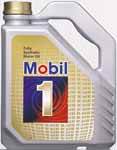 cost: just gone up to $60 |
Mobil 1 5W-50 is fancier than the blended 10W-30 Mobil 1 and not as dear as the top shelf 0W-40 Mobil 1. Not all Mobil 1's are the same! I am trying the 5W-50. Mobil recommend using Super XHP for the 90-97 V8 and Mobil Super GF-2 10W-30 or Mobil 1 5W-50 for the later model VVTi V8. The US market is different - different range of oils - no 5W-50 for example. Mobil v 5W-50 is the ultimate performance, fully synthetic race proven engine oil designed to provide unsurpassed protection for the engines of all petrol, LPG and diesel powered passenger cars, light trucks, 4WD's and vans. Mobil v 5W-50 is particularly suitable for high performance engines, especially those fitted with turbochargers, operating under the most severe conditions. This oil is formulated from wax-free synthesised hydrocarbons and a unique, proprietary additive system to provide exceptional thermal and oxidation stability. This, together with it's naturally high resistance to viscosity change with temperature, ensures that full protection is maintained at temperatures at which other oils begin to oxidise, degrade and thicken.
|
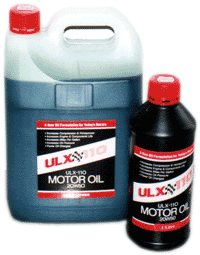 Cost: about $55 |
http://www.ulx110.com/Bullets.html
Wow! - this oil comes with some great claims! More power than Mobil 1, better than any whimpy full synthetic oil etc - sounds great! Aaron and I did dyno my car before and after with Mobil 1 and ULX-110 - no power gains - but the ULX was a 10W versus the 5000 km old 5W Mobil - the dyno graphs looked the same. No power gain for Amsoil over Mobil 1 either - we did it in Aarons car. So no power gain in my car, didn't measure compression or oil pressure, fuel economy wasn't measured accurately to tell if there was any difference. But a sample is in the lab so lets so how the engine and component life claim makes out for my V8.
|
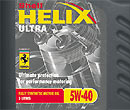 about $45 |
I wanted full syn for the Phillip Island Race meet so I have used Shell Ultra -
cheaper than Mobil 1, $45 versus $60 A premium grade,
fully synthetic engine oil scientifically formulated to provide the ultimate protection
for prestige and high performance vehicles. Shell Helix Ultra is recommended by Ferrari
and is used by Dick Johnson for the Shell Helix Racing Team. Available in 1 litre and 5
litre. |
I usually drain the oil for at least an hour with the jack on the battery side of the car so that all the old oil drains out of the drain plug on the throttle side. The whole car is tilted sideways to encourage all the old oil out of the drain plug. All the oil won't drain out on a level surface. I've had the oil flow from the drain plug stop with the car on a level surface, then jacked up the battery side of the car and the oil starts draining again..
Amsoil always get good wraps in tests - it's one of the few oils I've never heard a bad thing about - it seems to win all the magazine comparisons and get glowing reviews everywhere. Hard to separate the infomercial style of "news" and testimonial type from the real scientific tests. I might try Mobil 1 next and then some Amsoil - but that will be some 6 months away. So we need a DieHard out there to try it too. So if you can get an oil analysis done before and after, a dyno before and after would be nice too, and do a genuine oil filter change too then go for it and send me the results. Here is a collection of some Amsoil links:
http://www.onvic.com.au/motoring/magazine/oil/index.htm Very interesting reading - don't know the background of the author or if it is a genuine test or some infomercial style of presentation. I haven't seen any viscosity loss in my oil tests yet.
http://www.amsoil.com/ Amsoil corporate site. Amsoil recommend changing the filter more often than the oil.
Amsoil magazine test This is a Fast Fours and Rotors magazine article - the link went dead so this is the cached copy I saved when it was live.
http://www.whitepages.com.au/wp/ Type Amsoil in the white pages to find someone who sells it near you.
All serious users of lubricating oils - from race teams to industry - use oil analysis
to indicate the health of both the oil and the system that's being lubricated. Having an
oil analysis performed is also quite cheap - but how are the results of that testing to be
interpreted?
Oil Analysis Part 1
Last week we looked at interpreting the results gained by analysing oil with ICP
Spectroscopy, while this week we move onto Particle Quantification Index (PQI), Viscosity
measurement, and testing for the presence of water.
Oil Analysis Part 2
Oil classifications either describe viscosity or performance. When purchasing a can, drum
or tankerful of oil, it is important to realise that a number of international
classification systems are used to describe the product and its uses. The classifications,
which include ISO, SAE, API, CCMC, SABS ...
Reading Oil Specs Part 1
Is One Oil Better Than Another? In last week's story, the focus was on the viscosity
classification systems of lubricants, namely the International Standards Organization
(ISO) system for industrial lubricants and the Society of Automotive Engineers (SAE)
system for automotive oils. This article will ...
Reading Oil Specs Part 2
-for-life components or extended overhaul periods. In these cases the equipment has
exceeded the performance capabilities of conventional mineral oil based lubricants, and
created the need to develop synthetic oils. This article provides an introduction to the
wide-ranging topic of synthetic oil and ...
Synthetic Oils
But wait there's more!
by Ed Hackett http://rconcepts.com/beard/dragnet/drag/oilinfo.html
I think this site is informative and balanced. Good stuff.
http://www.fernblatt.com/longhurst/engineoil_bible.html
Lots of good information here too - let down a couple of times by some subjective statements like:
"Synthetic oils have been known to dislodge the baked-on deposits from mineral oils and leave them floating around your engine "
and
"If you've been running around on synthetic, don't change down to a mineral-based oil - your engine might not be able to cope with the degradation in lubrication"
These type of statements would never make it in AutoSpeed.
A 5000 km old AU Ford Falcon 6 cylinder car had the oil changed and the standard Motorcraft filter removed and cut open. The filter was blocked and the oil was filthy. Sure you can make Ford jokes but the thrust of the story was that even on a brand new car (worse because everything is bedding in? - with my brand new Statesman SuperCharged I had a couple of years ago there was an optional oil change for the 1500 km service - I took it) the oil and filter needed changing. Then their was some anecdotal stories of other "experienced people" who agreed that in a car with over 50 000 km, chances are the oil filter is in bypass mode (i.e. clogged) after 3000 km. So the moral of this story was change the filter every 5000 km regardless.